
Circuit Diagram
Index 152
35W Audio Amplifier based LM391
Published:2013/3/13 1:20:00 Author:Ecco | Keyword: 35W , Audio Amplifier
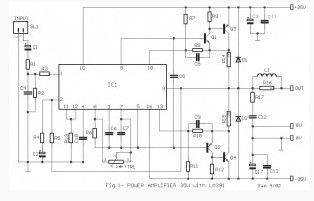
This is the circuit diagram of a 35W audio amplifier based on LM391. The LM391 is a comprehensive driver to the power transistors. It needs only few external components to work. With the TR1 we can adjust the bias current to 45mA. Inductor L1 consists of 20 turns of wire thickness of 0.9mm, around the resistor R16. The transistors Q3-4 must be placed onto a heatsinks. If you use the Q3-4 with type of TIPxxxx, you can be placed directly onto the board. But if you use packaged transistors TO-3, then it should be connected with short cables to the respective positions of the board.
(View)
View full Circuit Diagram | Comments | Reading(1595)
RIAA Stereo Preamplifier Classic Version based on NE5532
Published:2013/3/13 1:19:00 Author:Ecco | Keyword: RIAA , Stereo Preamplifier, Classic Version
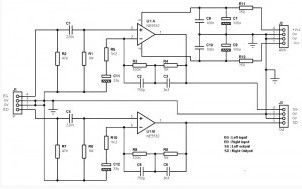
ThisRIAA stereo preamplifier uses only conventional components, you can easily find components at electronics store. The circuit is intended to be used with a vinyl turntable equipped with analog outputs (RCA). It provides the dual function of preamplifier and RIAA correction. This circuit is suitable for a MM (Moving Magnet), and is not suitable for a MC (Moving Coil).
(View)
View full Circuit Diagram | Comments | Reading(1556)
RIAA Stereo Preamplifier Classic Version based on NE5534
Published:2013/3/13 1:17:00 Author:Ecco | Keyword: RIAA , Stereo Preamplifier , Classic Version
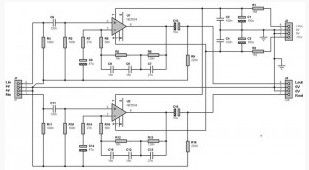
Here the RIAA stereo preamplifier classic version based on NE5534. This setting is intended for use with a vinyl turntable equipped with an analog output (RCA). It provides the dual function of pre-amplification and RIAA correction. This RIAA pre amp circuit is suitable for MM cells (Moving Magnet), and is not suitable for cell MC (Moving Coil). It is slightly more efficient than “RIAA stereo preamplifier classic version, based on the NE5532″.
(View)
View full Circuit Diagram | Comments | Reading(1587)
Simple RIAA Preamplifier using Logic IC CD4069
Published:2013/3/13 1:14:00 Author:Ecco | Keyword: Simple, RIAA Preamplifier, Logic IC
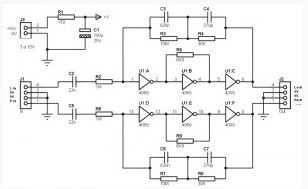
The simple RIAA preamplifier circuit is just to show that we can sometimes change the role of a component. It is possible to use this type of inverting logic gates CD4069 for the read head signal amplification for vinyl turntable. The same thing can be considered for a microphone preamp.
(View)
View full Circuit Diagram | Comments | Reading(1933)
Video Amplifier Circuit based IC LM359
Published:2013/3/13 1:09:00 Author:Ecco | Keyword: Video Amplifier
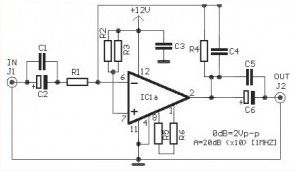
This is the simple and easy to build video amplifier circuit based IC LM359. The LM359 is a Dual, high speed, programmable and Current Mode (Norton) amplifier chip which can be used for general purpose video amplifiers.
(View)
View full Circuit Diagram | Comments | Reading(1952)
Hydrophone Preamplifier based on Op-Amp OPA37
Published:2013/3/13 1:08:00 Author:Ecco | Keyword: Hydrophone Preamplifier
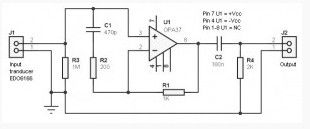
This is Hydrophone preamplifier circuit diagram, designed to be used with a transducer type EDO6166, and is taken from an application note of OPA27/37 of Burr-Brown.
As you can see, it’s really very simple and uses only conventional components. The transducer used, is piezo type and has a relatively high output impedance, which requires a preamp with a high input impedance. The input impedance of this circuit is mainly determined by the value of the resistor R3, 1 MOhms here. The value of other components determines the frequency range used, it ranges here between 1 kHz and 50 kHz.
(View)
View full Circuit Diagram | Comments | Reading(2179)
Amplifier Circuit using MOSFET Output Stage
Published:2013/3/13 1:07:00 Author:Ecco | Keyword: Amplifier, MOSFET Output Stage
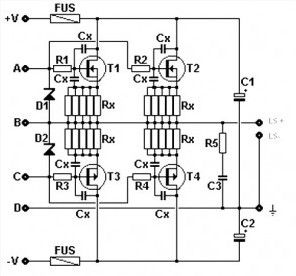
The circuit presented here is amplifier circuit using MOSFET output stages, as a substitute for the output stage based on bipolar transistors. This project is for those who want to experiment with the power MOSFET. Without going into details, the MOSFET has a characteristic sound of vacuum tubes and bipolar transistors. The main advantages MOSFET Amplifier : simplicity of operation, hundreds of watts with a simple parallel, negative temperature coefficient and fast switching times. The main disadvantages : a high input capacity from 500 to 1000 pF, sensitivity to electrostatic discharge.
MOSFETs are available in a very wide range in the PNP and NPN, the voltage from 100 to 200 volts or more, additional models (such as bipolar). Model commonly used in power amplifiers are 10N16, 10P16, IRFP140, IRFP9140, IRFP240, IRFP9240, 2SK135, 2SJ50, 2SK1530, 2SJ201. In this project, points A and C are connected to the output of the driver stage, point B is to counter-reaction and the point D the mass driver. Board is planned for the case TO3P transistors, it will slightly bend the foot for TO220-type packages.
(View)
View full Circuit Diagram | Comments | Reading(2143)
Headphones Amplifier based LM741
Published:2013/3/13 1:06:00 Author:Ecco | Keyword: Headphones Amplifier
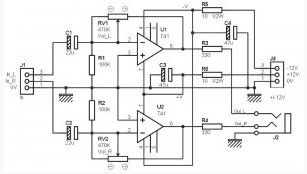
You can see this Headphones amplifier circuit more complete, since it shows all the components required for both left and right channels. Dont expect miracles from this type of circuit, the distortion can be quite important if you push too much volume. If you are looking for a headphone amp that sounds “loud and clear”, this amplifier will probably not live up to your expectations. But in ‘normal’ use, it is a good small Headphones amplifier.
(View)
View full Circuit Diagram | Comments | Reading(1346)
100W Basic MOSFET amplifier
Published:2013/3/13 1:04:00 Author:Ecco | Keyword: 100W , Basic MOSFET amplifier
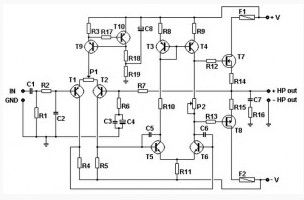
This Basic MOSFET amplifier is very simple to build and low cost. Is perfect for Hi-Fi amplifiers and instrument amplifiers (guitar, keyboards …). Output power is + / – 100 Wrms at 8 ohm load or + / – 160 Wrms below 4 ohms. The simplicity of this circuit cause distortion + / -0.1%. Bandwidth at -3 dB is from 4 Hz to 96 Khz and it is limited by C1, R1, R2 and C2.
Transistors T1 and T2 makes a first differential stage, current source of +/- 1 mA is set by R3. P1 allows a fine tuning of DC voltage at amplifier’s output. Place P1 at it’s half value for first power up, then turn it slowly for a lowest DC output voltage. It is recommended to use a first quality component.
Input sensitivity is 1.2 volts. The gain of 27x is archived by R7/R6. It may be modified by changing R7 value. Transistors T5 and T6 makes the second differential stage. Transistors T3 and T4 works as a current mirror source. They push the second differential stage to drain equal current. Doing so we get a high gain and an excellent linearity. Output MOSFET transistors works in AB class, their quiescient current is set from 50 to 100 mA trough P2.
(View)
View full Circuit Diagram | Comments | Reading(3707)
200 Watt MOSFET Amplifier
Published:2013/3/13 1:03:00 Author:Ecco | Keyword: 200 Watt, MOSFET Amplifier
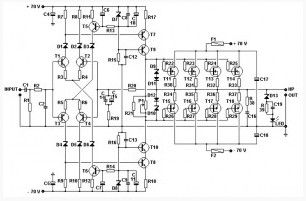
This circuit have Power output is 200 Wrms in 8 ohms or 350 Wrms into 4 ohms. Less than 0.02% distortion, damping factor greater than 300, the ratio signal / noise 112 dB (A balanced at full power), input sensitivity is 1.2 volts (200 W / 8 ohms).
Current source of + / – 1 mA carried around T5 and T6. Diodes D1 to D6 allow the use of low-noise type BC560C and BC550C transistors, transistor T7 to T10 is the driver stage. Potentiometer P1 allows setting the quiescent current of 100 mA per output transistor.
Symmetrical power entrusted to the large transformer 625 VA, 2 * 51 volts + bridge rectifier and 4700 uF capacitor 6, which gives the output voltage of + and – 70 volts per rail.
(View)
View full Circuit Diagram | Comments | Reading(3023)
5 Watt Audio Amplifier based LA4460
Published:2013/3/13 1:02:00 Author:Ecco | Keyword: 5 Watt, Audio Amplifier
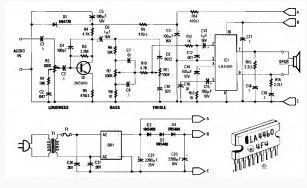
This 5 W audio power amplifier is built for general purpose and can drive speakers approximately 8 to 12 inches. This 5W power amplifier circuit is based on the Sanyo LA4460 IC which used as an audio output.
This Low-power amplifier circuit have built in loudness control, driver amplifier Q1, and the bass/treble controls of around ± 10 dB boost / cut. It would be useful in a wide variety of situations. Either displayed ac supply can be used, or 12 VDC supply can be connected to points A & B (positive) and C (negative).
For stereo circuit can be used two of this circuit by using ganged potentiometer at R2, R7 and R11. T1 is 12V at 1 ampere plug-in transformer.
(View)
View full Circuit Diagram | Comments | Reading(1553)
4 Watt / 900Mhz RF Amplifier
Published:2013/3/13 1:01:00 Author:Ecco | Keyword: 4 Watt , 900Mhz , RF Amplifier
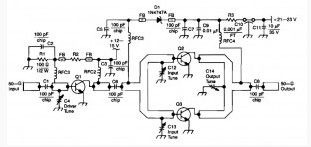
This RF amplifier circuit has a power output of 4 Watts at a frequency of 900 Mhz. Applying Wilkinson power dividers in the base and collector circuits of Q2 and Q3, a couple of SD1853 driver application transistor are paralleled for double the power output of the 2-W amplifier.
(View)
View full Circuit Diagram | Comments | Reading(1753)
1500 Watt RF Amplifier Circuit
Published:2013/3/13 0:59:00 Author:Ecco | Keyword: 1500 Watt, RF Amplifier
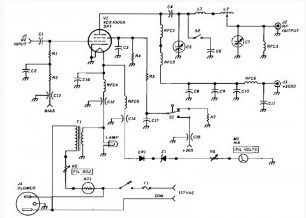
This 1500 watt RF amplifier circuit can be used to drive your transmitter antenna, it can also include driving to the source of the RF high power, microwave heating, and draw the structure of the resonant cavity.
(View)
View full Circuit Diagram | Comments | Reading(1438)
Pulse forming circuit with integral circuit
Published:2013/3/12 3:32:00 Author:Ecco | Keyword: Pulse forming , integral circuit
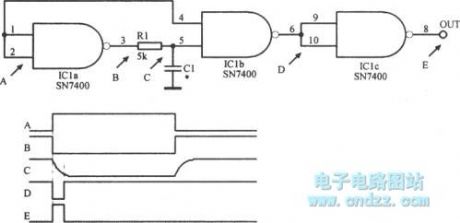
Pulse forming circuit with integral circuit is shown as figure.
(View)
View full Circuit Diagram | Comments | Reading(1069)
RC control circuit
Published:2013/3/12 3:30:00 Author:Ecco | Keyword: RC control
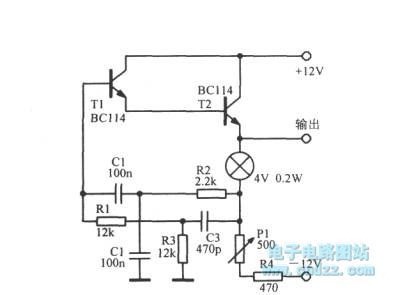
RC control circuit is shown as figure.
(View)
View full Circuit Diagram | Comments | Reading(1000)
1Hz clock signal oscillator
Published:2013/3/12 3:27:00 Author:Ecco | Keyword: 1Hz , clock signal oscillator
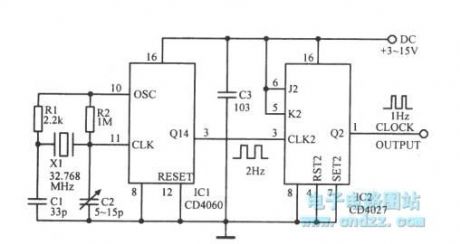
1Hz clock signal oscillator is shown as figure.
(View)
View full Circuit Diagram | Comments | Reading(2883)
0.5 seconds tone burst circuit
Published:2013/3/12 3:29:00 Author:Ecco | Keyword: 0.5 seconds , tone burst circuit
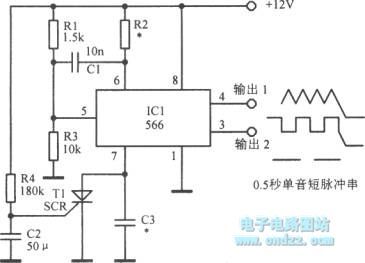
0.5 seconds tone burst circuit is shown as figure.
(View)
View full Circuit Diagram | Comments | Reading(895)
General Purpose 5 Watt Audio Amplifier based LA4460
Published:2013/3/12 1:42:00 Author:Ecco | Keyword: General Purpose , 5 Watt, Audio Amplifier
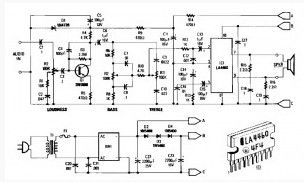
The 5 Watt audio amplifier shown here are suitable for driving the speaker size 8 to 12 inch. Here used an audio output from Sanyo LA4460 IC. The IC is actually used for car radio or car audio power amplifier and may deliver output power up to 12 W. But in this circuit is only used 5W.
The 5 W audio amplifier circuit consists of loudness control, driver amplifier Q1, and the bass and treble controls of approximately ± 10 dB boost / cut. Either the ac supply shown in here can be used, or a 12 Vdc supply can be connected to points A&B (positive) and C (negative). Two of these circuits, using ganged potentiometers at R2, R7, and R11 can be used for stereo applications. T1 is a 12Volt 1 ampere plug-in transformer. Notice that IC1 must be heatsinked. Power output is about 5 W. A 4″ x 2″ x 0.050″ aluminum heatsink should be adequate.
(View)
View full Circuit Diagram | Comments | Reading(1223)
Preamplifier for magnetic phono cartridges
Published:2013/3/12 1:38:00 Author:Ecco | Keyword: Preamplifier , magnetic phono cartridges
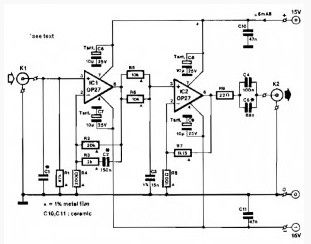
This amplifier circuit is intended to be added to the preamplifier which does not have a phono input. Such a phono input is required for normal record players with a dynamic pick-up, of which millions are still around. Moreover, the amplifier does not only bring the output of the pick-up to line level, it also adds the correction to the frequency response (according to RIAA requirements).
When recording gramophone records, the frequency characteristic is lifted at the high end. This lift must be countered in the playback (pre)amplifier. The corrections to the frequency response characteristic are according to a norm set by the Record Industries Association of America (RIAA) and also by the IEC.
The corrective curve provided by the amplifier is shown in the graph (bold line). The thin line shows the ideal corrective curve. The sharp bends in this at 50 and 500 Hz are nearly obtained in the practical curve by network R3/C2; just above 2 kHz is approached in practice by filter R5/R6/C3. The arrangement of R3/C2 in the feedback loop of IC1 gives noticeably better results than the usual (passive) filter approach.
(View)
View full Circuit Diagram | Comments | Reading(0)
30 watt audio amplifier based TDA2040
Published:2013/3/12 1:37:00 Author:Ecco | Keyword: 30 watt , audio amplifier
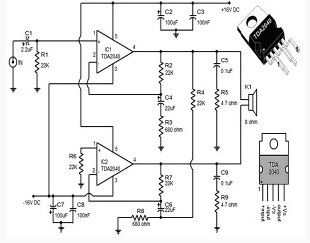
A 30 watt audio amplifier circuit using TDA2040 are shown here. TDA2040 is class AB monolithic integrated audio amplifier available in the package Pentawatt. The IC has a low harmonic distortion and has a built in circuit protection for short circuit.
In the circuit, two TDA2040 ICs are wired in BTL (bridge-tied load) configuration to provide 30W of output into 8 ohm speakers at + /-16V DC. The capacitor C1 is the decoupling capacitor DC input. Network with components R2, C4, R3 provides feedback for IC1 while R7, C6, R8 network provides information for IC2. Network C5, R5 and C9, R9 provides stability at high frequency. Capacitors C2, C3 filters the positive supply rail while the capacitors C7, C8 filters the negative supply rail.
(View)
View full Circuit Diagram | Comments | Reading(3774)
| Pages:152/2234 At 20141142143144145146147148149150151152153154155156157158159160Under 20 |
Circuit Categories
power supply circuit
Amplifier Circuit
Basic Circuit
LED and Light Circuit
Sensor Circuit
Signal Processing
Electrical Equipment Circuit
Control Circuit
Remote Control Circuit
A/D-D/A Converter Circuit
Audio Circuit
Measuring and Test Circuit
Communication Circuit
Computer-Related Circuit
555 Circuit
Automotive Circuit
Repairing Circuit